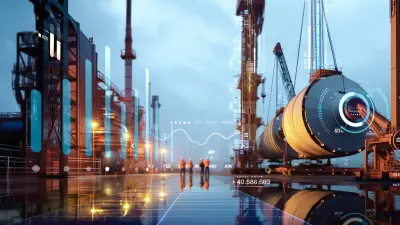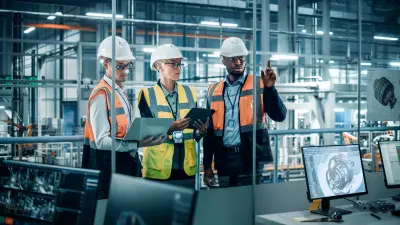More Energy, less Capex: How ADNOC Offshore is Redefining Production with Physics-Infused AI
Transforming Ultrafiltration System performance through digital twins

In the offshore oil and gas industry, every barrel counts. Margins are tight, operations are complex, and the balance between growth and cost is constantly under pressure. For decades, the default response to rising demand was straightforward: build more: new plants, new pipelines, more capital.
Yet each expansion comes with staggering costs for operators, long lead times, and rising environmental scrutiny. What if the capacity for growth is already hidden within existing assets – waiting to be unlocked?
Even with full support from the equipment manufacturer, the operator had to run the plant below its intended limits. “It was like owning a high-performance reality-based hybrid digital twinning engine that could never shift out of second gear,” recalls Dr. Slahadin Ali Ashair, Chief Architect & Visionary of Adnoc Digital Factory Intelligent Operation Center. “Every attempt to push harder ended in failure, and the quality of water injection remained a challenge”.
Faced with mounting losses, the team of ADNOC Offshore had two options: invest heavily in a new facility or find a way to extract more from what was already in place.
A different lens on performance: Physics meets AI

To uncover untapped performance, ADNOC Offshore Digital Factory (AODF) partnered with International Development Company (IDC) and Bosch Digital Twin Industries (BDTI) – a venture of Bosch Business Innovations, the corporate venture builder of Bosch. Leveraging more than 140 years of Bosch’s engineering heritage, BDTI applied a hybrid modelling approach combining high-fidelity simulations with advanced physics-powered AI analytics.
Working side by side the team of Dr. Slahadin Ali Ashair, based on his patented AODF concept of HDT (Hybrid Digital Twining) motivated by his reality-based prescriptive analytics concept, BDTI was able to build a digital twin of the Sulphate Reduction Plant – a dynamic, system-level model that mirrors real plant behavior. The digital twin generated stress conditions on key components such as filters or pumps, revealing hidden inefficiencies and mechanical interactions invisible to conventional analysis tools.
“Together, we could see inside the system in a way never possible before,” explains Rajesh Kothandan, Principal Architect at Bosch Digital Twin Industries. “For the first time, our customer understood why the plant resisted higher loads – and how to overcome those limits safely.”

Results that change the equation
The impact was immediate: Within months, the plant’s oil production capacity increased by +7.5% (barrels per day) without new construction or major equipment changes. As the digital twin expands across all filtration stages, projections indicate a cumulative gain of +12.5%.
Equally significant was the financial outcome: millions of dollars in capital expenditure deferred, freeing resources for other strategic initiatives. Day-to-day operations shifted, too. Near real-time monitoring and predictive intelligence will allow the plant to anticipate failures rather than react to them.
“Instead of waiting for breakdowns, we envision to have the foresight to prevent them”, says Rahul Verma, Digital Twin Architect at BDTI. “It’s a completely different way of running this facility.”
However, the journey is far from over: now, ADNOC Offshore is planning on integrating BDTI’s Physics Infused AI-powered asset performance management platform to its plant, ensuring continuous monitoring in real time, predictive maintenance, operational scenario testing, and long-term scalability.
The digital twin evolves with each data cycle – learning, adapting, and safeguarding capacity for the future.
“At the heart of this journey lies a shared vision with ADNOC Offshore, to move beyond monitoring and co-create a new standard for operational foresight. It’s deeply fulfilling to see how our partnership is driving real, measurable value and reshaping how reliability is perceived in the industry.” says Bharat Oruganti, Sales & Partnerships Manager at BDTI.
A blueprint for complex industries
This successful collaboration demonstrates how even long-standing operational limits can be overcome when deep engineering expertise meets digital intelligence.
By merging physics-based modeling with AI-driven intelligence, Bosch Digital Twin Industries enabled turn a production bottleneck into a high-performance asset.
The plant didn’t need replacement. It needed understanding,” concludes Rajesh Kothandan. “That’s the power of a digital twin.”
For operators worldwide, the message is clear: you don’t always need to build more to achieve more. The key lies in making the invisible visible.
About Bosch Digital Twin Industries
Bosch Digital Twin Industries is a venture of Bosch Business Innovations and empowers industries worldwide with intelligent, explainable digital twins to eliminate unplanned downtime, optimize asset & process performance, and unlock hidden capacity. With decades of engineering heritage, Bosch Digital Twins combine high-fidelity physics-based simulations with AI to deliver measurable, sustainable value for organizations across energy and industrial infrastructure.
About Bosch Business Innovations
Bosch Business Innovations is the corporate venture builder of Robert Bosch GmbH. With one of the largest patent libraries in the world, a leading research and development department, and access to international talent, Bosch’s venture builder creates scalable start-ups that stay ahead of the market.
The corporate venture builder supports ventures from TRL 4–5 through to investment readiness, relying on co-investments, internal talent, and external operational leaders and CEOs, as well as close collaborations with international partners and universities.
Through the business models it develops, Bosch Business Innovations addresses global challenges and demonstrates that corporate venture building supports the long-term success of modern enterprises.
For more information about Bosch Business Innovations, visit https://www.bosch-business-innovations.com/



